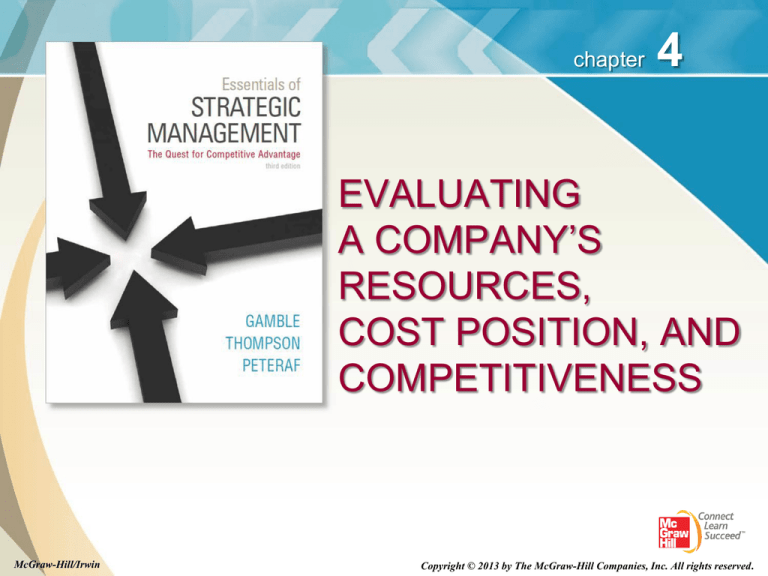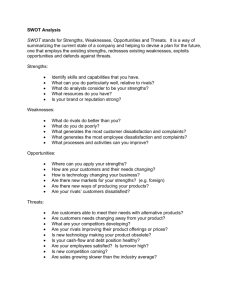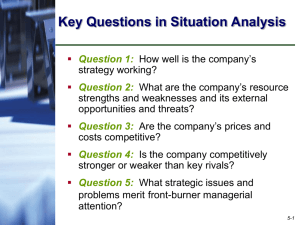
chapter
4
EVALUATING
A COMPANY’S
RESOURCES,
COST POSITION, AND
COMPETITIVENESS
McGraw-Hill/Irwin
Copyright © 2013 by The McGraw-Hill Companies, Inc. All rights reserved.
LO1 Learn how to assess how well a company’s
current strategy is working.
LO2 Understand why a company’s resources and
capabilities are central to its strategic approach
and how to evaluate their potential for giving
the company a competitive edge over rivals.
LO3 Grasp how and why activities performed
internally by a company and those performed
externally by its suppliers and forward channel
allies determine a company’s cost structure and
the value it provides to customers.
4-2
(cont’d)
LO4 Learn how to evaluate a company’s competitive
strength relative to key rivals.
LO5 Understand how a comprehensive evaluation
of a company’s external and internal situations
can assist managers in making critical
decisions about their next strategic moves.
4-3
“Where Are We Now?”
Question 1
How well is the firm’s strategy working?
Question 2
What are the firm’s competitively important
resources and capabilities?
Question 3
Are the firm’s cost structure and customer
value proposition competitive?
Question 4
Is the firm competitively stronger or weaker
than key rivals?
Question 5
What strategic issues and problems merit
front-burner managerial attention?
4-4
Question 1: How Well Is the Company’s
Strategy Working?
The
two best indicators of how well a firm’s
strategy is working are:
Whether the firm is recording gains in financial
strength and profitability.
Whether the firm’s competitive strength and market
standing is improving.
4-5
Strategy Performance Indicators
Trends in the firm’s sales and earnings growth.
Trends in the firm’s stock price.
The firm’s overall financial strength.
The firm’s customer retention rate.
The rate at which new customers are acquired.
Changes in the firm’s image and reputation with
customers.
Evidence of improvement in internal processes
such as defect rate, order fulfillment, delivery times,
days of inventory, and employee productivity.
4-6
Question 2: What Are the Company’s
Competitively Important Resources
and Capabilities?
A
company’s strategy and business model:
Must be well-matched to its collection of resources
and capabilities
Is strengthened when exploiting resources that are
competitively valuable, rare, hard to copy, and not
easily trumped by rivals’ equivalent substitute
resources
4-7
Identifying Competitively Important
Resources and Capabilities
Common
types of valuable resources and
competitive capabilities include:
Skills or specialized expertise in a competitively
important capability
Valuable physical assets
Valuable human assets or intellectual capital
Valuable organizational assets
Valuable intangible assets
Competitively valuable alliances or cooperative
ventures
4-8
Core Concept
A resource is a competitive asset that
is owned or controlled by a firm; a
capability is the capacity of a firm to
competently perform some internal
activity. Capabilities are developed
and enabled through the deployment
of a firm’s resources.
4-9
TABLE 4.1
Common Types of Tangible and Intangible Resources
Tangible Resources
Physical
resources
State-of-the-art manufacturing plants and equipment, efficient
distribution facilities, attractive real estate locations, or ownership
of valuable natural resource deposits
Financial
resources
Cash and cash equivalents, marketable securities, and other
financial assets such as a company’s credit rating and borrowing
capacity
Technological
assets
Patents, copyrights, superior production technology, and
technologies that enable activities
Organizational
resources
Information and communication systems (servers, workstations,
etc.), proven quality control systems, and strong network of
distributors or retail dealers
4-10
TABLE 4.1
Common Types of Tangible and Intangible Resources
Intangible Resources
Human assets and
intellectual capital
An experienced and capable workforce, talented employees
in key areas, collective learning embedded in the
organization, or proven managerial know-how
Brand, image, and
reputational assets
Brand names, trademarks, product or company image,
buyer loyalty, and reputation for quality, superior service
Relationships
Alliances or joint ventures that provide access to
technologies, specialized know-how, or geographic markets,
and trust established with various partners
Company culture
The norms of behavior, business principles, and ingrained
beliefs within the company
4-11
Determining the Competitive Power of a
Company’s Resources and Capabilities
Is the resource or capability
really competitively valuable?
Is the resource or capability rare—
is it something rivals lack?
Competitive
Power Tests
Is the resource or capability
hard to copy or imitate?
Can the resource or capability be
trumped by substitute resources
and competitive capabilities?
4-12
Core Concept
A core competence is a proficiently performed
internal activity that is central to a company’s
strategy and competitiveness.
A core competence that is performed with a
very high level of proficiency is referred to as
a distinctive competence.
4-13
Core Concept
Companies that lack a stand-alone resource
that is competitively powerful may
nonetheless develop a competitive advantage
through resource bundles that enable the
superior performance of important crossfunctional capabilities.
Rather than try to match the resources
possessed by a rival firm, a firm may develop
entirely different resources that substitute for
the strengths of the rival.
4-14
A Company’s Resources and
Capabilities Must Be Managed
Dynamically
Management’s
organization-building
challenge has two elements:
1. Attending to ongoing recalibration of existing
capabilities and resources
2. Casting a watchful eye for opportunities to develop
totally new capabilities for delivering better customer
value and/or outcompeting rivals
4-15
Core Concept
A dynamic capability is developed when a
company has become proficient in modifying,
upgrading, or deepening its resources and
capabilities to sustain its competitiveness and
prepare it to seize future market opportunities
and nullify external threats to its well-being.
4-16
Are Company Resources and Capabilities
Sufficient to Allow It to Seize Market
Opportunities and Nullify External Threats?
SWOT
represents the first letter in:
Strengths Weaknesses Opportunities Threats
A
well-conceived strategy is:
Matched to the firm’s resource strengths and
weaknesses
Aimed at capturing the firm’s best market
opportunities and defending against external
threats to its well-being
4-17
Core Concept
SWOT analysis is a simple but powerful
tool for sizing up a firm’s internal strengths
and competitive deficiencies, its market
opportunities, and the external threats to its
future well-being.
4-18
Identifying a Company’s
Internal Strengths
A
firm’s strengths determine whether its
competitive power in the marketplace will be
impressively strong or disappointingly weak.
A
firm that is well endowed with strengths
stemming from potent resources and core
competencies normally has considerable
competitive power.
4-19
TABLE 4.2
Factors to Consider When Identifying a Company’s
Strengths, Weaknesses, Opportunities, and Threats
Potential Internal Strengths and Competitive Capabilities
•Core competencies in ____ .
•A strong financial condition; ample financial resources to grow the business.
•Strong brand name image/company reputation.
•Economies of scale and/or learning and experience curve advantages over rivals.
•Proprietary technology/superior technological skills/important patents.
•Cost advantages over rivals.
•Product innovation capabilities.
•Proven capabilities in improving production processes.
•Good supply chain management capabilities.
•Good customer service capabilities.
•Better product quality relative to rivals.
•Wide geographic coverage and/or strong global distribution capability.
•Alliances/joint ventures with other firms that provide access to valuable technology,
competencies, and/or attractive geographic markets.
4-20
Identifying Resource Weaknesses
and Competitive Deficiencies
A
weakness or competitive deficiency is
something a firm lacks or does poorly or
a condition that puts it at a disadvantage
in the marketplace such as:
Deficiencies in competitively important physical,
organizational, or intangible assets
Missing or competitively inferior capabilities
in key areas
4-21
TABLE 4.2
Factors to Consider When Identifying a Company’s
Strengths, Weaknesses, Opportunities, and Threats
Potential Internal Weaknesses and Competitive Deficiencies
•No clear strategic direction.
•No well-developed or proven core competencies.
•A weak balance sheet; burdened with too much debt.
•Higher overall unit costs relative to key competitors.
•A product/service with features and attributes inferior to those of rivals.
•Too narrow a product line relative to rivals.
•Weak brand image or reputation.
•Weaker dealer network than key rivals.
•Behind on product quality, R&D, and/or technological know-how.
•Lack of management depth.
•Short on financial resources to grow the business and pursue promising
initiatives.
4-22
TABLE 4.2
Factors to Consider When Identifying a Company’s
Strengths, Weaknesses, Opportunities, and Threats
Potential Market Opportunities
•Serving additional customer groups or market segments.
•Expanding into new geographic markets.
•Expanding the firm’s product line to meet a broader range of
customer needs.
•Utilizing existing company skills or technological know-how to enter
new product lines or new businesses.
•Falling trade barriers in attractive foreign markets.
•Acquiring rival firms or companies with attractive technological
expertise or capabilities.
4-23
Identifying a Company’s
Market Opportunities
Opportunities
that are most relevant
to a firm are those offering:
Good match with its financial and
organizational resource capabilities
The best prospects for growth and profitability
The most potential for competitive advantage
4-24
Identifying Threats to a Company’s
Future Profitability
The emergence of cheaper or better technologies
Rivals’ introduction of new or improved products
The entry of lower-cost foreign competitors into a
firm’s market stronghold
New regulations that are more burdensome
to a firm than to its competitors
Vulnerability of the firm to a rise in interest rates
The potential of a hostile takeover
Unfavorable demographic shifts
Adverse changes in foreign exchange rates
4-25
TABLE 4.2
Factors to Consider When Identifying a Company’s
Strengths, Weaknesses, Opportunities, and Threats
Potential External Threats to a Company’s Future Prospects
•Increasing intensity of competition among industry rivals—may squeeze profit
margins.
•Slowdowns in market growth.
•Likely entry of potent new competitors.
•Growing bargaining power of customers or suppliers.
•A shift in buyer needs and tastes away from the industry’s product.
•Adverse demographic changes that threaten to curtail demand for the industry’s
product.
•Vulnerability to unfavorable industry driving forces.
•Restrictive trade policies on the part of foreign governments.
•Costly new regulatory requirements.
4-26
The Value of a SWOT Analysis
The
value of a SWOT analysis is in:
Drawing conclusions from the SWOT listings
about the firm’s overall situation.
Translating these conclusions into strategic
actions to better match the firm’s strategy to its
strengths and market opportunities, correcting
problematic weaknesses, and defending against
worrisome external threats.
4-27
Question 3: Are the Company’s Cost
Structure and Customer Value
Proposition Competitive?
Why
are cost structure and value important?
Assessing whether a firm’s costs and value
proposition are competitive is crucial, especially so in
industries where price competition is prevalent.
Useful
analytical tools:
Value chain analysis
Benchmarking
4-28
Core Concept
A company’s value chain identifies
the primary activities that create
customer value and related
support activities.
4-29
FIGURE 4.1
A Representative Company Value Chain
4-30
FIGURE 4.1
A Representative Company Value Chain
4-31
Concepts and Connections 4.1
Value Chain Activities and Costs for Just Coffee,
a Producer of Fair Trade Organic Coffee
4-32
Benchmarking: A Tool for Assessing
Whether a Company’s Value Chain
Activities Are Competitive
Entails
making cross-company comparisons
of how certain activities are performed and
the costs associated with:
How materials are purchased
How inventories are managed
How products are assembled
How customer orders are filled and shipped
How maintenance is performed
4-33
Core Concept
Benchmarking is a potent tool for learning
which firms are best at performing particular
activities and then using their techniques (or
“best practices”) to improve the cost and
effectiveness of a firm’s own internal activities.
4-34
FIGURE 4.2
Representative Value Chain for an Entire Industry
4-35
The Value Chain System
for an Entire Industry
A firm’s customer value proposition and cost
competitiveness depend not only on its internally
performed activities, but also on the value chain
activities of its suppliers and forward channel allies.
Accurately assessing the competitiveness of a
firm’s cost structure and value proposition requires
that managers understand an industry’s entire value
chain system for delivering a product or service to
customers, not just the firm’s own internal value
chain.
4-36
Strategic Options for Remedying
a Cost or Value Disadvantage
There
are three main areas of a firm’s overall
value chain where cost differences occur:
Activities performed by suppliers
A firm’s own internal activities
Activities performed by forward channel allies
4-37
Remedying an Internal Cost
or Value Disadvantage
1. Implement the use of best practices throughout the firm
2. Eliminate some cost-producing activities by revamping value
chain
3. Relocate high-cost activities to lower-cost geographic areas
4. See if certain internally performed activities can be
outsourced to vendors or contractors
5. Invest in productivity-enhancing, cost-saving technology
6. Find ways around activities or items where costs are high
7. Redesign the product and/or its components to reduce
manufacturing or assembly costs
8. Make up differences by reducing costs in supplier or forward
portions of value chain system
4-38
Remedying a Supplier-Related
Cost Disadvantage
Pressure
Switch
suppliers for lower prices
to lower-priced substitutes
Collaborate
closely with suppliers to identify
mutual cost-saving opportunities
Integrate
backward into business of highcost suppliers
4-39
Remedying a Cost Disadvantage
Associated with Activities
Performed by Forward Channel Allies
Pressure
dealer-distributors and other
forward channel allies to reduce their costs
and markups
Work with forward channel allies to identify
win-win opportunities to reduce costs
Change to a more economical distribution
strategy:
Switch to cheaper distribution channels
Integrate forward into company-owned retail outlets
4-40
Question 4: What Is the Company’s
Competitive Strength Relative
to Key Rivals?
Determining
a firm’s overall competitive
position involves answering two questions:
1. How does the firm rank relative to its competitors
on each industry key success factor?
2. Does the firm have a net competitive advantage
or disadvantage vis-à-vis its major competitors?
4-41
Steps in a Competitive Strength Assessment
Step 1
List the industry’s key success factors and other measures
of competitive strength or weakness (6 to 10 measures).
Step 2
Assign a weight to each measure of competitive strength based
on its importance in shaping competitive success. (The sum of
the weights for each measure must add up to 1.0.)
Step 3
Calculate strength ratings by scoring each competitor on each
strength measure (use a scale where 1 is weak and 10 is strong)
and multiplying the assigned rating by the assigned weight.
Step 4
Sum the weighted strength ratings on each factor to get an overall
measure of competitive strength for each company being rated.
Step 5
Use the overall strength ratings to draw conclusions about the size
and extent of the firm’s net competitive advantage or disadvantage
and to take specific note of areas of strength and weakness.
4-42
TABLE 4.3
Illustration of a Competitive Strength Assessment
4-43
Interpreting the Competitive
Strength Assessments
Shows
how firm stacks up against rivals,
measure by measure
Indicates
whether firm is at a competitive
advantage or disadvantage against each
rival
Identifies
possible offensive strategies that
can be waged against rivals’ weaknesses
Identifies
the need for defensive actions to
correct competitive weaknesses
4-44
Question 5: What Strategic Issues
and Problems Must Be Addressed
by Management?
Final
and most important analytical step
in assessing “Where are we now?”
The results of industry and competitive analyses
pinpoint the issues and problems that management
must address in setting its agenda for actions to take
next to improve the firm’s performance and business
outlook.
4-45







